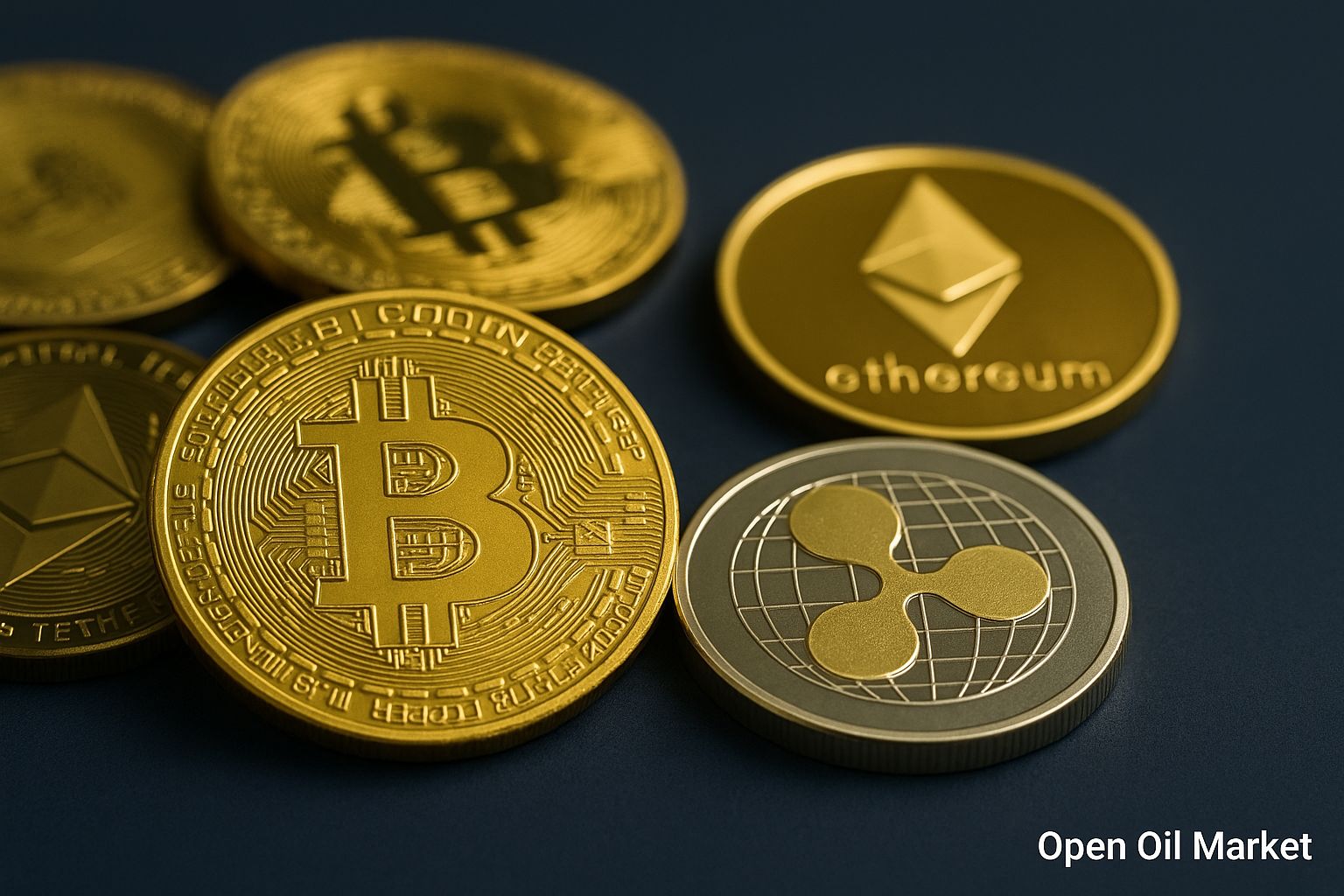
Current Cryptocurrency News for October 21, 2025: Bitcoin Holds Above $110K After Volatility, Ethereum Stays Around $4,000, and Altcoins Resume Growth. Investor Sentiment Improves Amid Expectations of Fed Policy Easing; Review of the Top 10 Popular Cryptocurrencies, Institutional Trends, and Market Forecasts.
As of the morning of October 21, 2025, the cryptocurrency market is showing a confident recovery after recent volatility. Bitcoin is holding above the key level of $110,000, having regained much of the decline from the previous week and supporting the overall market capitalization growth (over $3.5 trillion). Following Bitcoin, Ethereum and most leading altcoins are strengthening: nearly all of the top 10 digital assets are trading in the "green zone." Investors, including institutional ones, are gradually returning to the market amid improving sentiment, interest in new crypto ETFs, and a favorable regulatory environment.
Bitcoin Stabilizes After Volatility Spikes
The flagship of the crypto market, Bitcoin (BTC), is consolidating around the $110–112K mark as of October 21, maintaining its position after a sharp surge and subsequent correction earlier in the month. In the first week of October, Bitcoin managed to set a new all-time high, exceeding approximately $125K amidst "Uptober" effects and a frenzied influx of capital. However, unexpected news – particularly the U.S. statement about the introduction of 100% tariffs on imports from China – triggered a brief "flash crash": BTC's price swiftly dropped nearly 15%, falling to just above $100,000, before finding support. Nonetheless, by mid-month, Bitcoin regained most of the drop and rose above $110,000 again, confirming its resilience. The current price is approximately 2–3% lower than peak values, but significantly exceeds levels from the previous month; since the beginning of the year, BTC has gained about 45%, outperforming most traditional assets. Bitcoin's market capitalization is currently estimated at around $2.2–2.3 trillion, accounting for about 60% of the entire cryptocurrency market's capitalization.
Despite recent fluctuations, the fundamental factors for Bitcoin remain positive. The U.S. Federal Reserve is signaling a readiness to ease monetary policy: recent statements from Fed officials have strengthened expectations for a rate cut at the upcoming meeting at the end of October. The prospect of cheaper money supports demand for “digital gold” among investors. Additionally, the U.S. maintains a crypto-friendly environment — the administration continues its support for the industry, having earlier allowed the inclusion of BTC in 401(k) retirement plans and initiated the creation of a government crypto reserve. Institutional inflows are also providing additional momentum to the market: the first spot Bitcoin ETF in the U.S. (from BlackRock), launched at the beginning of the month, attracted over $1.5 billion in investments in its first weeks, demonstrating a high appetite from large players. Certain public companies have also taken advantage of the price drop: for instance, mining firm Marathon Digital Holdings disclosed a purchase of approximately 400 BTC last week, a move the market interprets as a signal of confidence. Experts note that Bitcoin's robust recovery after the downturn has raised traders' and investors' confidence: many consider the recent decline merely a technical pause within an ongoing bullish trend. Major investment banks (JPMorgan, Standard Chartered, among others) maintain optimistic forecasts, expecting Bitcoin's price to reach $150–200K by year-end, provided the macroeconomic conditions remain favorable.
Ethereum and Leading Altcoins
The second-largest crypto asset, Ethereum (ETH), is also demonstrating stability and gradual recovery. The price of Ethereum is again holding above the psychologically important level of $4,000, currently fluctuating in the range of $4,050–4,100, approximately 15% lower than its recent peak. In early October, following Bitcoin's performance, ETH surged to around $4,900, setting a new all-time high for the first time in four years (the previous record of $4,890 was set in November 2021). Following this, Ether corrected alongside the broader market, dropping about 15%, but managed to stabilize around the $4,000 mark, thus preserving most of its previous gains. Ethereum's current market capitalization stands at about $500 billion (≈13% of the market), further solidifying its status as the largest altcoin.
Demand for Ether is supported by fundamental factors. The Ethereum blockchain remains a key platform for the decentralized finance (DeFi) ecosystem, NFTs, and numerous dApps, ensuring interest in ETH persists even amid market fluctuations. Investors are also optimistic about anticipated technological updates to the network. A scheduled protocol upgrade (codenamed "Fusaka") aimed at improving scalability and security is expected in the coming weeks, which will potentially reduce fees and enhance throughput. Additionally, rumors are circulating that the U.S. Securities and Exchange Commission (SEC) is close to approving the first spot ETF for Ether – a development that could occur within the current quarter, serving as a powerful driver for ETH. Institutional interest in Ethereum is also apparent: open interest in ETH futures at the Chicago Mercantile Exchange (CME) reached a record level at the beginning of the month (equivalent to over $11 billion), while funds focused on Ether are drawing increased investor attention. Collectively, these factors indicate strong confidence from major players in Ethereum's long-term potential, despite short-term fluctuations.
Among other leading digital coins, Binance Coin (BNB) stands out – the native token of the largest cryptocurrency exchange, Binance. In October, BNB experienced sharp price swings: after hitting a new record (above $1,300 at the start of the month), the token fell to around $860 in the midst of a sell-off, but then rapidly rebounded. As of now, BNB is trading around $1,150 per coin, slightly below its historical high. Despite legal and regulatory challenges surrounding Binance, the BNB coin firmly maintains its place in the top 5 due to its wide range of applications, being used for trading fee payments, participating in new token launchpads, staking, and various DeFi services within the BNB Chain ecosystem.
XRP – the token of the Ripple payment network for cross-border payments – continues to hold its ground. XRP is currently consolidating around $2.5, having more than doubled since the beginning of the year. In 2025, XRP experienced a significant rally following Ripple's legal victory over the SEC in the U.S.: the court ruled that XRP trading does not violate securities laws, eliminating regulatory uncertainty. This legal clarity has restored investor confidence, allowing XRP to return to the top five largest cryptocurrencies by market capitalization (approximately $140 billion). Despite a recent correction from peak levels of around $3, the Ripple token continues to enjoy high demand, remaining one of the key assets in the blockchain payments sector.
Altcoin Market: Solana, Cardano, and Others
The broader altcoin market is showing synchronized improvement alongside Bitcoin and Ethereum. Solana (SOL), one of the fastest-growing platforms for smart contracts, is holding near $190–200, demonstrating relative resilience. Just a week ago, SOL was outperforming the market, but with the return of activity in DeFi applications built on Solana, its price has rebounded vigorously. Interest in SOL is further fueled by expectations that Solana may be the next cryptocurrency to receive approval for an exchange-traded fund (ETF) in the U.S. If a spot SOL ETF is approved, Solana will be the first protocol after BTC and ETH to have its own fund on the traditional market, attracting even more institutional attention to the coin. Moreover, the Solana ecosystem continues to develop dynamically, with new DeFi platforms and NFT marketplaces launching, increasing the fundamental value of SOL in the long term.
Another notable altcoin is Cardano (ADA), a blockchain platform developed with a scientific approach. ADA is currently trading around $0.68, stabilizing after sharp fluctuations in previous months. Previously, on the back of rumors about an ETF launch, the price of Cardano surged nearly to $1.0, but subsequently corrected by 30% from those peaks. Nevertheless, interest in the Cardano project remains high: the team continues to implement technological updates (such as the Hydra scaling protocol), and a vast community of supporters believes in the long-term growth of the ecosystem. Many ADA holders anticipate that the improvement of network features and the potential launch of investment products based on Cardano will eventually help the token achieve new highs.
The top ten largest cryptocurrencies by market capitalization also includes diverse projects such as Dogecoin and Tron. The meme cryptocurrency Dogecoin (DOGE), originally created as a joke, is currently trading around $0.18–0.20 and maintains its place among market leaders. Despite a more than 20% drop in early October, DOGE quickly recovered thanks to the devoted community and periodic celebrity attention. The volatility of this coin remains high, but investor interest in the "meme" asset proves surprisingly resilient, allowing Dogecoin to stay in the top ten. The Tron (TRX) platform, focused on decentralized entertainment and Web3, is trading near $0.30–0.32. TRON has gained popularity in Asia, with its ecosystem attracting users through staking opportunities and low fees. Notably, a significant portion of the stablecoin USDT is issued on the Tron blockchain, creating strong demand for TRX in transactions. The presence of Dogecoin and Tron among the leaders highlights the diversity of the crypto industry: alongside high-tech platforms, investors value niche projects focused on community and specific applications.
Institutional Trends: Cautious Optimism Returns
In mid-autumn, the behavior of major institutional investors in the crypto market reflects cautious optimism. On one hand, recent volatility prompted some players to lock in profits: last week saw outflows from several crypto ETFs. According to industry analysts, the total net outflow of capital from spot Bitcoin funds in the U.S. was approximately $1.2 billion, while Ethereum ETFs experienced outflows of about $300 million (partly due to price corrections and position reallocations). These figures indicate that some investors have temporarily reduced their risk exposure in light of falling prices.
On the other hand, the strategic interest of major capital in cryptocurrencies is not waning but rather continues to grow. In 2025, U.S. regulators have already approved several spot exchange-traded funds for digital assets, significantly simplifying access for institutional investors to the crypto market. It is expected that by year-end, new ETFs may gain approval – discussions are underway for funds on several leading altcoins, including Solana and XRP. The emergence of such products will expand opportunities for conservative investors to invest in cryptocurrencies through familiar exchange instruments.
Additionally, the integration of cryptocurrencies into the traditional financial system continues. Large banks and fintech companies worldwide are announcing new services related to digital assets. In the U.S., several fintech banks (e.g., Brex) have begun supporting payments in the USDC stablecoin for their clients, while some regional banks are experimenting with issuing their own stablecoins to expedite interbank payments. In the European Union, a comprehensive regulatory package called MiCA came into effect this summer, establishing transparent rules for the crypto industry, while Hong Kong has introduced licensing for stablecoin providers – these steps globally elevate trust in the industry and attract institutions. Overall, despite short-term market fluctuations, significant financial players are not retreating from their crypto projects. On the contrary, there is an acceleration of investments in blockchain startups and infrastructure: the corporate sector views distributed ledger technologies as one of the drivers for future growth. Thus, although temporarily some funds have been withdrawn from cryptocurrencies due to heightened volatility, the strategic interest of institutions in digital assets remains an upward trend.
Market Sentiment and Volatility
The sharp price fluctuations of early October significantly impacted market participants' sentiments, but the situation is gradually stabilizing. Just a week ago, the Cryptocurrency Fear and Greed Index fell into the "extreme fear" zone amid panic selling – the shock from the sudden price plunge was profound. However, as prices have recovered, the indicator has rebounded: the current reading of the index is around 45 out of 100, which still corresponds to a state of "fear," but is a significant improvement from the recent lows. It can be said that the euphoria of early October has completely evaporated, but extreme panic is also behind us – investors' sentiments are gradually shifting towards neutrality.
Moreover, the volumes of forced liquidations on derivative crypto exchanges have also declined to average levels. During the peak of the decline on October 10-11, an unprecedented $19 billion worth of positions were liquidated (over 1.5 million traders were affected), but in recent days exchanges are now liquidating only hundreds of millions of dollars daily. This indicates that the market has shed a significant share of excessively risky and over-leveraged positions, relieving the pressure from margin calls. Experts note that such "cleaning" of excess leverage can be healthy for the market: removing overheated speculative positions lays a more solid foundation for future growth.
Nevertheless, market participants should remain prepared for increased volatility. Geopolitical factors, such as escalating trade disputes between the U.S. and China, can spark a new wave of price fluctuations in risk assets at any moment. Additionally, significant events that the crypto community is watching lie ahead: central bank interest rate decisions, publication of macroeconomic data, and potential announcements from regulators. Any surprises on these fronts could either spur a new rally or provoke another round of correction. In the short term, the market is likely to continue alternating between growth periods and pullbacks as it digests news; however, in the absence of new shocks, the underlying optimism among investors remains intact.
Forecasts and Expectations
Despite recent fluctuations, many analysts maintain a positive outlook for cryptocurrencies by the end of 2025. The overall bullish sentiment is supported by expectations of imminent easing of monetary policy: if the U.S. Fed indeed begins to cut interest rates, this could spur a new influx of capital into high-yield asset markets, including Bitcoin and Ethereum. Several investment firms raised their price targets in October: some forecasts from major banks suggest Bitcoin could rise to between $150,000 and $180,000 within the next 3–6 months. For Ethereum, optimistic scenarios foresee moves towards $6,000 and above, especially if the ETF launch and technological updates to the network are successful.
Conservatively-minded experts, however, warn that the path to new peaks may be uneven. Following such a powerful rally, further volatility spikes are possible, particularly as Bitcoin's price approaches significant psychological levels (e.g., $130,000 and $150,000). In the event of adverse geopolitical developments or delays in rate cuts, the market could linger in a flat state for an extended time or deepen its correction. Nevertheless, historical experience shows that every deep pullback in the crypto market is eventually followed by a resurgence. Investors are advised to adhere to risk management principles: diversify portfolios, avoid excessive leverage, and resist emotional reactions during panic sell-offs. The cryptocurrency sector still has strong fundamental growth drivers – and given favorable macroeconomic conditions, many specialists expect the market to conclude the year on a high note by setting new all-time highs.
Top 10 Most Popular Cryptocurrencies
As of the morning of October 21, 2025, the ten largest and most popular digital assets by market capitalization are as follows:
- Bitcoin (BTC) – the first and largest cryptocurrency, serving as a proxy for "digital gold." BTC is trading around $111,000, remaining close to its record values. Bitcoin's capitalization exceeds $2.2 trillion (about 60% of the total market) and continues to set the tone for the dynamics of the crypto market.
- Ethereum (ETH) – the second-largest cryptocurrency asset and the main platform for smart contracts, DeFi, and NFTs. ETH is valued at around $4,100, slightly below its all-time peak (~$4,900). Market capitalization of Ethereum is approximately $500 billion (≈13% of the market). Ethereum is actively evolving to enhance scalability, supporting long-term investor interest.
- Binance Coin (BNB) – the exchange token of the largest exchange, Binance, and the native coin of the BNB Chain ecosystem. The current price of BNB is around $1,150. In October, the token set a maximum (≈$1,300) and remains in the top 3 due to its broad range of applications (trade fee payments, DeFi participation, etc.). BNB's market capitalization is estimated at around $170–180 billion.
- Tether (USDT) – the largest stablecoin pegged to the U.S. dollar at a 1:1 ratio. USDT is widely used for trading and transactions on cryptocurrency exchanges. Its price remains stable at $1.00 (≈80 ₽), and its capitalization is around $160–170 billion. USDT plays a crucial role in the ecosystem, providing liquidity and hedging against risks.
- XRP (Ripple) – the token of the Ripple payment platform for cross-border transfers. XRP is trading around $2.5; with a market capitalization of (~$140 billion) it is established among the market's top five. Ripple's legal success against the SEC has removed uncertainties around XRP, boosting investor confidence. The token continues to represent one of the key assets in the global payments sphere.
- Solana (SOL) – a high-performance blockchain platform for decentralized applications. SOL is priced at around $190 per coin (market cap ~ $90–100 billion), rebounding after recent corrections. Solana is attracting attention for its scalability and ecosystem development, as well as expectations of its own ETF launch, which supports its position in the top 10.
- USD Coin (USDC) – the second-largest stablecoin backed by dollar reserves (issued by Circle). USDC is strictly pegged to $1.00, with a market capitalization around $65 billion. USDC is popular among institutional investors and in DeFi due to its transparency of reserves and regulation, playing a vital role in trading and payment operations.
- Dogecoin (DOGE) – the most well-known "meme" cryptocurrency created for a joke. DOGE is trading around $0.19 (market capitalization ~$28 billion) after a drop from September peaks. The coin remains in demand due to its devoted community and occasional media mentions. Despite high volatility, Dogecoin continues to be among the top ten coins, demonstrating remarkable resilience of investor interest.
- Cardano (ADA) – a smart-contract platform developed with a research-based approach. ADA is trading around $0.68 (market capitalization ~$25 billion) after a correction from recent peaks near $1.0. The project is attracting attention due to planned technological updates and the potential launch of ADA-based ETFs. An active community and improvements in technology support Cardano's long-term prospects.
- TRON (TRX) – a blockchain platform for creating decentralized applications and digital entertainment, especially popular in Asia. TRX is trading around $0.32; its market capitalization is estimated at approximately $30 billion. TRON is known for its extensive use of its network for issuing stablecoins (a significant share of USDT operates on Tron) and offers staking opportunities, ensuring stable demand for the token. The project continues to develop its Web3 ecosystem, maintaining its place among market leaders.
Cryptocurrency Market on the Morning of October 21, 2025
- Major cryptocurrency prices: Bitcoin (BTC) — $111,000; Ethereum (ETH) — $4,050; XRP — $2.50; BNB — $1,130; Solana (SOL) — $190; Cardano (ADA) — $0.68.
- Market indicators: total market capitalization ≈ $3.8 trillion; Bitcoin's share ≈ 59–60%; fear and greed index = 45 (fear zone, improvement from last week).
- Leaders in change for the day: growth – Synthetix (SNX) +20%; decline – Myx Finance (MYX) -7%.
- Analysis: Bitcoin and Ethereum are consolidating around current levels after turbulent trading, indicating a relative market calm. Although sentiment index remains in the fear zone, it has significantly recovered from extreme values – panic sentiments have eased, and investors have adopted a wait-and-see position. The leading growth has been seen in the DeFi protocol token SNX, which attracted attention with a sharp daily jump – this indicates local interest in altcoins amid the general recovery. The 7% drop in MYX reflects profit-taking on low-liquidity assets after the recent rally. Overall, the cryptocurrency market demonstrates resilience: key metrics remain healthy, and investor interest is gradually returning. This establishes a solid foundation for a potential new rally after a consolidation phase if external conditions remain favorable.




